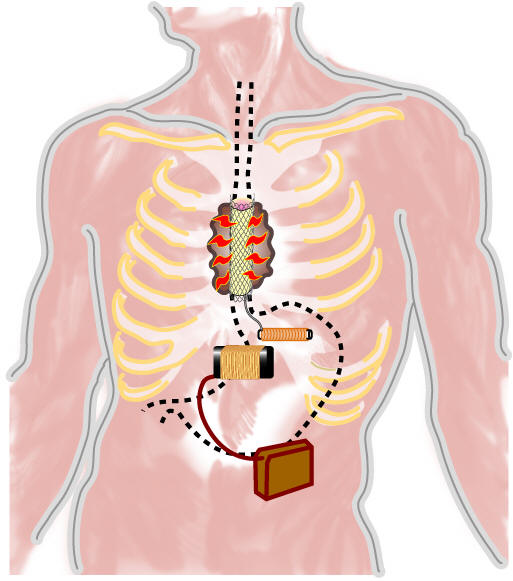|
New
Invention:
World’s First Artificial Multifunctional
Internal Organ
with Peristaltic Functions Used in the
Treatment of Cancer Patients
The Tohoku University’s research team has
developed a multifunctional stent, the world’s first
artificial internal organ of its kind and the patent
application has been filed with Toki Corporation.
The multifunctional stent can be used in the
treatment of cancer and other peristaltic disorders allowing
food to be swallowed with little resistance.
Members of the research team are Professor
Tomoyuki Yambe (Department of Medical Engineering and
Cardiology, Institute of Development Aging and Cancer),
Associate Professor Yoshio Hori (Biomedical Engineering
Research Organization) and Research Associate Fumihiro Sato
(Department of Electrical and Communication Engineering,
Graduate School of Engineering).
|
Hyperthermia therapy for the
treatment of cancer
Primary
coil which supplies energy to the body from outside |
    
|
Peristaltic activity to swallow food
by a nanotech artificial muscle
Secondary coil implanted within the
stomach
External body unit
|
Unfortunately, in the majority of cases found, it has been
beyond hopes to save esophageal cancer diseased patients.
Now, in order to allow swallowing, a metallic stent can be
used for cases in which the cancer is impossible to remove.
As the stent tends to block with food, the
patient unable to swallow even saliva often starts to vomit.
Whenever this occurs to the patient, he is reclassified and
cared as an emergency patient.
The Tohoku University’s research team has
succeeded in developing the world’s first multifunctional
stent by mimicking the body’s natural peristaltic movement
with the use of a shape-memory alloy artificial muscle
through the application of nanotechnology.
By creating an in-body coverage with
biocompatible high molecule slippery gel, the transmission
of food becomes smooth and through hyperthermia therapy
induced by external excitation, the progress of cancer is
decreased while improving immunity, which has been
successfully tested and experimented on animals.
Nanotechnology has possibilities in the development of new
artificial internal organs in such-a-small-scale and at
such-a-low-weight that makes it possible to be inserted in
the body by endoscope without the need of any surgical
incisions.
Nanotechnology is expected to be seen in other similar
applications for organs including biliary tract, pancreas,
ureter, urethra and aorta.
Since nanotech devices can be implanted and
removed by an endoscope, further development is planned and
can be applied to more common benignant diseases. The market
value of these devices is believed to be billions in US
dollars.
Achievement reports scheduled at the following three
conferences:
the Japanese Society for Artificial Organs
(November 30), the International ME Conference in Singapore
(from December 6 ) and the Japan Society for Endoscopic
Surgery (from December 7).
Contact:
Prof. Tomoyuki Yambe
Institute
of Development, Aging and Cancer
Tohoku University
Tel:+81-22-717-8517
Fax:+81-22-717-8518

|



